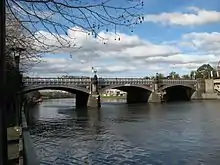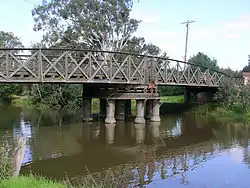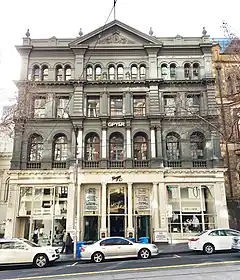John Harry Grainger | |
|---|---|
 Grainger in 1901 | |
| Born | 30 November 1854 |
| Died | 13 April 1917 (aged 62) |
| Resting place | Box Hill Cemetery, Melbourne |
| Nationality | English |
| Occupation | Engineer |
| Spouse |
Rose Annie Aldridge (m. 1880) |
| Children | Percy Grainger |
| Engineering career | |
| Discipline | civil engineer |
| Projects | Princes Bridge, Sale Swing Bridge |
John Harry Grainger (30 November 1854[1] – 15 April 1917[2]) was an Australian architect and civil engineer, who was also the father of musician Percy Grainger. He designed 14 bridges, notably Princes Bridge in Melbourne. As an architect, he designed half a dozen major public buildings, mainly in New Zealand, Perth, and Melbourne, notably the WA Supreme Court, while he was Principal Architect in the Architectural Division of the Public Works Department of Western Australia. He also designed some major commercial buildings in Melbourne (mostly demolished) such as Georges Store over his long career, between 1878 and 1915.
Family background
Grainger was born at 1 New Street, Westminster, Central London, into a Northumbrian family of builders, architects and engineers. His parents were John Grainger, a master tailor, and Mary Ann Grainger, née Parsons. He grew up in Durham. Percy Grainger related that he was told "Grainger Street" in Newcastle-on-Tyne was so called because an uncle or other relative had built most of the houses in the street.[1] John Grainger appears to have lived with an uncle while in England, but as his parents were not deceased—they are listed as still living in Westminster in the 1881 census—it is unclear why. Winifred Falconer, his companion later in life, wrote in an unpublished manuscript in the mid-1930s that he lived with an uncle who was an important influence on him during his childhood. The gentleman was a personal friend of the great theologian Cardinal Newman and the young Grainger "derived great pleasure as well as knowledge from listening to their discussions of the world’s affairs". His uncle was also interested in music and took Grainger to his personal box at the opera. Percy believed that his father received much of his education at a monastery school in France at Yvetot (between Le Havre and Paris).[3]: p.2
Early career
Grainger started his engineering training when he was fifteen, in the office of William E. Wilson MICE[4] of Dean's Yard, Westminster.[2] Wilson was a well-connected consultant to contractors for railway and other big projects.[5] Grainger also studied architecture under I. J. Eden & W. K. Green of Westminster. In the mid-1870s, while still in Wilson's employ, Grainger travelled throughout Europe, visiting Spain, Italy and France. An article in the Melbourne Age disclosed that Grainger learned how to construct iron bridges in London. "[He] worked with Mr Wilson, the well-known engineer of the Metro. District Railways and with him, iron bridge making has been a special study".[6]
Career in Australia
Eastern states
In 1877, at the age of 22, Grainger travelled to Australia and a position in the office of A. C. Mais, Engineer-in-Chief of the South Australian Public Works Department. He resigned in July 1878 after he had won a design competition for the Albert Bridge in Adelaide and was starting to get private work from a number of wealthy clients,[2]: p.1 including Robert Barr Smith and Thomas Elder. Grainger became involved in the musical life of Adelaide, organised the first string quartet in Adelaide, and provided space in their house for the string quartet to rehearse. Percy Grainger ascribes some of his exposure to music early on in his father's love of music.[1]
After winning two major bridge design competitions, most notably for Princes Bridge Melbourne, and for the Sale Swing Bridge in 1879, he visited Victoria for the first time in February 1880 to inspect the Sale site. In October 1880 he married Rose Annie Aldridge, daughter of an Adelaide hotel-keeper,[3]: p.3 in St Matthew's Church in Marryatville.[7] In 1882, the couple moved to Victoria and settled in the Melbourne suburb of North Brighton, where their only son, christened George Percy Grainger, was born on 8 July 1882.[8]


John Grainger was an accomplished artist, with broad cultural interests and a wide circle of friends.[9] These included David Mitchell, whose daughter Helen later gained worldwide fame as an operatic soprano under the name Nellie Melba. He designed Coombe Cottage, Nellie Melba's home in Coldstream.

For four years (1881–1885), he worked in partnership with an old friend, Charles D'Ebro, with whom he had sailed from England and with whom he had also worked in the South Australian Public Works Department.[2]: p.4 They designed many notable buildings together, not just in Melbourne, such as the Fremantle Town Hall in 1881, and in 1884 won the competition to design Auckland's public library and municipal offices (now the Auckland Art Gallery Toi o Tāmaki). Other notable designs included the 1884 Equitable Co-operative in Collins Street (later occupied by Georges (store), and a grand Masonic Hall on the Collins Street hill (demolished). The partnership ended in 1885, and it would appear that the friendship later faltered, as D'Ebro failed to provide effective support for Grainger's nomination in September 1906 as a Fellow of the Royal Victorian Institute of Architects (RVIA).[2]: p.8 Grainger then practiced alone, designing the Maryborough School of Arts, and in 1887-8 was the engineer for the striking six-storey red brick Tea House in South Melbourne, where he devised a unique solution of 450 ironbark piles and concrete rafts to cope with the swampy soil.[10]
Grainger was a heavy drinker and a womaniser who, Rose learned after the marriage, had fathered a child in England before coming to Australia. His promiscuous lifestyle placed heavy strains upon the relationship, particularly when Rose discovered shortly after Percy's birth that she had contracted a form of syphilis from her husband.[8][9] Despite this, the Graingers stayed together until 1890, when John embarked on a return sea voyage to England. At that time he was in very poor health and impoverished, having "lost all in over speculation in mines".[2]: pp.5–6
On his return to Australia he settled in Adelaide, living for a year or so with his wife's sister May and her husband George Sydney Aldridge. Most of his water colour paintings (of which there are 10 in the Grainger Museum) date from this second Adelaide period.[1] By 1895, he had sworn off drinking whisky and resumed a productive career which was undoubtedly enhanced by a happy relationship with a new life partner, Winifred Falconer. Following a share slump in Adelaide, the two moved in 1896 to Kalgoorlie,[2]: p.6 Western Australia, where a major gold rush was in progress and he resided there for some three months, employed by Adelaide mining and cement entrepreneur, Richard Durrant Langley.
Western Australia
Though Western Australia was booming in the 1890s, the eastern states were then in recession and he was fortunate to be appointed Principal Architect in the Architectural Division of the Public Works Department at a salary of £600, commencing 1 March 1897, a position which he held until 31 July 1905 when he retired owing to ill health. Hillson Beasley had been acting in the position since November 1903.[2]: p.8 His projects included the Government House ballroom (1899),[11] Supreme Court, former Perth Museum, Library and Art Gallery, Parliament House, Perth (1899–1904), Perth Central Police Courts, the Old Northam Railway Station, and a number of substantial goldfields buildings, including the Warden's Court, Coolgardie and the Public Buildings in Kalgoorlie.[2]: p.7
Return to Victoria

After pursuing a curative journey in Europe with his companion Winifred Falconer, Grainger returned to Melbourne in 1906, where he was awarded first prize in a design competition for the administrative block of the Melbourne Town Hall. Though experiencing the debilitating symptoms and pain of tertiary syphilis, he continued in practice in partnership with Phillip Kennedy and John Little as Grainger, Kennedy and Little. By 1910 the firm was reduced to Grainger and Little but continued to secure significant projects, including the first stage of the State Savings Bank in Elizabeth Street, and Collins House (both now demolished).[13] Grainger retired in 1915, but his name lived on in the firm Grainger, Little and Barlow for many years. He died two years later in 1917,[2]: p.9 and was buried at Box Hill Cemetery in an unmarked grave. A headstone was finally erected in 2013.[14]
Bridge designs
In August 1879, at the age of 24, having already designed Adelaide's Albert Bridge, and while still resident in Adelaide, he entered a partnership in Melbourne (Jenkins and Grainger—sometimes spelt Granger) through which he forwarded designs for two new bridges in Victoria. One was for a new Princes Bridge over the Yarra River in Melbourne, the other a unique swing bridge over the Latrobe River at Sale.[15] These were entirely his own work, both earning him lucrative first prizes and being followed by construction of the prestigious bridges.[16]
He overcame chronic illness to design at least 14 bridges as well as five water supply and irrigation schemes, and a large number of buildings, many of which are on heritage registers in Australia and New Zealand.[2]: p.1
References
- 1 2 3 4 John Grainger: A Brief Biographical Background Archived 24 April 2011 at the Wayback Machine, Grainger Museum (University of Melbourne). Although Percy Grainger erroneously recorded 1855 as his father's birth year, a footnote states that 1854 is the correct year.
- 1 2 3 4 5 6 7 8 9 10 11 Tibbits, G. R. and Beauchamp, D. John Harry Grainger: Engineer and Architect Archived 12 February 2013 at the Wayback Machine at 3rd Australasian Engineering Heritage Conference 2009. Retrieved 15 January 2013. (Also available (pay per view) at Australian Journal of Multi-disciplinary Engineering, Vol. 8, No. 1, 2010: 11–22. ISSN 1448-8388)
- 1 2 Allison, Brian John Harry Grainger: Architect and civil engineer University of Melbourne Collections, 38 Issue 1, November 2007. Retrieved 14 January 2013
- ↑ Member of the Institution of Civil Engineers
- ↑ Chapter XII - The Millwall Docks at British History Online
- ↑ Designs for Prince's Bridge at Melbourne Argus, 4 August 1879, p.6 via Trove
- ↑ "Percy Grainger in Adelaide". Stephen Orr, writer. Retrieved 25 June 2019.
- 1 2 Bird, John, Percy Grainger, Faber & Faber London 1982 pp. 2–6 ISBN 0-571-11717-1
- 1 2 Simon, Robert, Percy Grainger: The Pictorial Biography, Whitston Albany, New York, 1983
- ↑ "Robur Tea House". Victorian Heritage Database. Retrieved 26 October 2018.
- ↑ The Ballroom at W.A. Government House official website
- ↑ "East Melbourne, Clarendon Street 068, 070, Vizard House | East Melbourne Historical Society". emhs.org.au. Retrieved 3 March 2023.
- ↑ "John Harry Grainger - Career". Culture Victoria. Creative Victoria. Retrieved 26 October 2018.
- ↑ Deborah Gough, "Welcome Grainger: RIP after a long wait", The Age, 22 June 2013. Retrieved 16 May 2016
- ↑ Dreyfus, Kay (2006). Grainger, George Percy (1882–1961). Australian Dictionary of Biography online. Retrieved 20 April 2011.
- ↑ The Proposed New Railway Workshops at South Australian Chronicle, 9 August 1879, p.4S via Trove
External links
- Grainger Museum University of Melbourne, Australia]
- John Harry Grainger, Culture Victoria